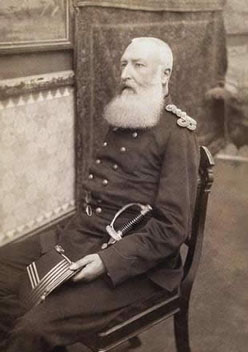| Leopold II  AKA Léopold Louis Philippe Marie Victor AKA Léopold Louis Philippe Marie Victor
Born: 9-Apr-1835
Birthplace: Brussels, Belgium
Died: 17-Dec-1909
Location of death: Laeken, Belgium
Cause of death: unspecified
Remains: Buried, Notre Dame Church, Laeken, Belgium
Gender: Male
Race or Ethnicity: White
Sexual orientation: Straight
Occupation: Royalty Nationality: Belgium
Executive summary: King of Belgium, 1865-1909 Leopold II, King of the Belgians, son of Leopold I, was born at Brussels on the 9th of April 1835. In 1846 he was created Duke of Brabant and appointed a sub-lieutenant in the army, in which he served until his accession, by which time he had reached the rank of lieutenant-general. On attaining his majority he was made a member of the senate, in whose proceedings he took a lively interest, especially in matters concerning the development of Belgium and its trade. On the 22nd of August 1853 Leopold married Marie Henriette (1836-1902), daughter of the Archduke Joseph of Austria, Palatine of Hungary, by his wife Marie Dorothea, Duchess of Württemberg. This princess, who was a great-granddaughter of the empress Maria Theresa, and a great-niece of Marie Antoinette, endeared herself to the people by her elevated character and indefatigable benevolence, while her beauty gained for her the sobriquet of "The Rose of Brabant"; she was also an accomplished artist and musician, and a fine horsewoman. Between the years 1854 and 1865 Leopold travelled much abroad, visiting India and China as well as Egypt and the countries on the Mediterranean coast of Africa. On the 10th of December 1865 he succeeded his father. On the 28th of January 1869 he lost his only son. Leopold (b. 1859), Duke of Hainaut. The king's brother Philip, count of Flanders (1837-1905), then became heir to the throne; and on his death his son Albert (b. 1875) became heir-presumptive. During the Franco-Prussian War (1870-71) the king of the Belgians preserved neutrality in a period of unusual difficulty and danger. But the most notable event in Leopold's career was the foundation of the Congo Free State. While still Duke of Brabant he had been the first to call the attention of the Belgians to the need of enlarging their horizon beyond sea, and after his accession to the throne he gave the first impulse towards the development of this idea by founding in 1876 the Association Internationale Africaine. He enlisted the services of Henry Morton Stanley, who visited Brussels in 1878 after exploring the Congo river, and returned in 1879 to the Congo as agent of the Comité d'Études du Haut Congo, soon afterwards reorganized as the "International Association of the Congo." This association was, in 1884-85, recognized by the powers as a sovereign state under the name of the État Indépendant du Congo. Leopold's exploitation of this vast territory, which he administered autocratically, and in which he associated himself personally with various financial schemes, was understood to bring him an enormous fortune; it was the subject of acutely hostile criticism, to a large extent substantiated by the report of a commission of inquiry instituted by the king himself in 1904, and followed in 1908 by the annexation of the state to Belgium. In 1880 Leopold sought an interview with General C. G. Gordon and obtained his promise, subject to the approval of the British government, to enter the Belgian service on the Congo. Three years later Leopold claimed fulfilment of the promise, and Gordon was about to proceed to the Congo when the British government required his services for the Sudan. On the 15th of November 1902 King Leopold's life was attempted in Brussels by an Italian anarchist named Rubino. Queen Marie Henriette died at Spa on the 19th of September of the same year. Besides the son already mentioned she had borne to Leopold three daughters -- Louise Marie Amélie (b. 1858), who in 1875 married Philip of Saxe-Coburg and Gotha, and was divorced in 1906; Stéphanie (b. 1864), who married Rudolph, crown prince of Austria, in 1881, and after his death in 1889 married, against her father's wishes, Elemer, Count Lonyay, in 1900; and Clémentine (b. 1872). At the time of the queen's death an unseemly incident was occasioned by Leopold's refusal to see his daughter Stéphanie, who in consequence was not present at her mother's funeral. The disagreeable impression on the public mind thus created was deepened by an unfortunate litigation, lasting for two years (1904-06), over the deceased queen's will, in which the creditors of the princess Louise, together with princess Stéphanie (Countess Lonyay), claimed that under the Belgian law the queen's estate was entitled to half of her husband's property. This claim was disallowed by the Belgian courts. The king died at Laeken, near Brussels, on the 17th of December 1909. On the 23rd of that month his nephew took the oath to observe the constitution, assuming the title of Albert I. King Leopold was personally a man of considerable attainments and much strength of character, but he was a notoriously dissolute monarch, who even to the last offended decent opinion by his indulgences at Paris and on the Riviera. The wealth he amassed from the Congo he spent, no doubt, royally not only in this way but also on public improvements in Belgium; but he had a hard heart towards the natives of his distant possession. Father: Leopold I (King of Belgium)
Mother: Princesse Louise-Marie Thérèse Charlotte Isabelle d'Orléans
Wife: Marie Henriette (b. 1836, m. 22-Aug-1853, d. 1902)
Son: Leopold (b. 1859, d. 28-Jan-1869)
Daughter: Louise Marie Amélie (b. 1858)
Daughter: Stéphanie (b. 1864)
Daughter: Clémentine (b. 1872)
Belgian Monarch (10-Dec-1865 to 17-Dec-1909)
Assassination Attempt 15-Nov-1902, Brussels
Requires Flash 7+ and Javascript.
Do you know something we don't?
Submit a correction or make a comment about this profile
Copyright ©2019 Soylent Communications
|